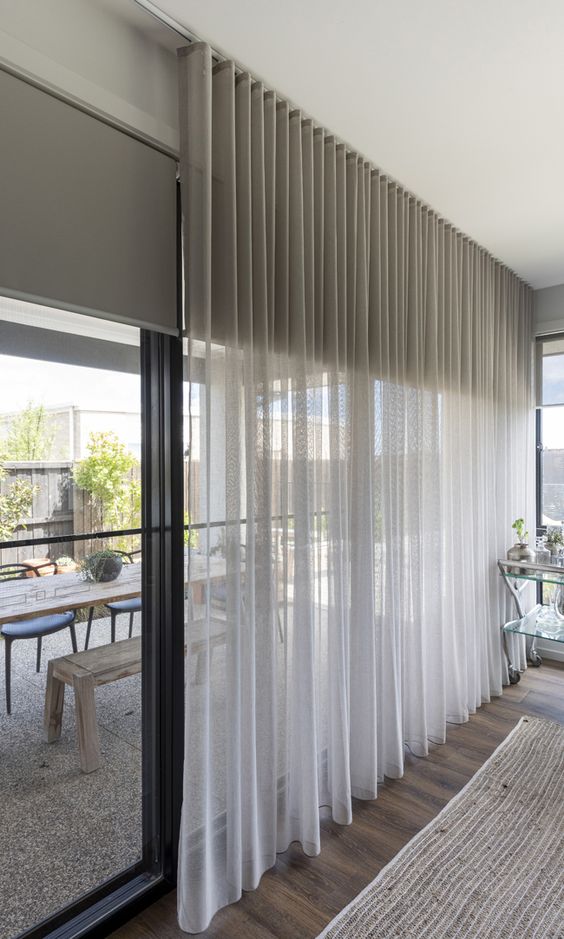“Curtains are to windows as eyelashes are to the eyes; they give depth, dimension, and a finishing touch to the room’s expression.” Curtains and Blinds
– William Diamon
This blog aims to explore innovative DIY ideas that will transform your blinds and curtains from mundane to mesmerising. We will guide you through creative ways to infuse luxury into these essential elements of your home decor. Whether it is adding embellishments, experimenting with fabrics or incorporating materials, With our assistance, you can transform your window treatments into eye catching design elements that enhance the appeal of your living area and represent your unique style. Come along on this journey to redefine the possibilities and learn how little adjustments can have a big impact on the interior design of your house.

Curtains and Blinds in Interior Design
Blinds and curtains are the unsung heroes of interior design. They hold the ability to transform an ordinary space into something spectacular. As London interior designers, witnessing the ‘wow’ expression on our client’s faces when we meticulously stage the site with carefully curated soft furnishing is incredibly rewarding; these elements have the ability to effortlessly tie the entire space together. It creates a cohesive and harmonious ambiance that truly captivates the eye. They are more than just useful window covering; rather, they are essential components that create the mood of a space, regulate light, improve privacy and elevate any interior.

Blinds are made of slats or vanes that provide a sleek, contemporary look. They are available in a variety of styles, including vertical, roller, and Venetian. Their adaptability is rooted in their ability to precisely control natural light. This means that residents can pull or adjust the slats to manage the amount of sunlight that enters the space. Because they provide a room with control over light and privacy, blinds are an essential component of interior design, greatly enhancing both comfort and functionality.
Together, blinds and curtains provide a tasteful fusion of design and utility. While curtains offer warmth and character, blinds are more functional and sleek. A room’s overall aesthetic can be greatly influenced by the way these window treatments interact, improving its visual appeal and fostering a cosy atmosphere.
Combining Curtains and Blinds
When curtains and blinds are paired, your interior design can reach new heights and radiate luxury and sophistication with a polished finishing touch. When curtains and blinds are strategically combined, your room is improved and an elegant designer look is introduced without the expensive price tag that comes with high-end decor.
Layering is a common method in the art of blending blinds and curtains. A neat, polished look can be achieved by installing blinds inside the window frame, and hanging curtains from above to gracefully frame the window and slightly overlap the blinds. By adding depth, this layering technique enhances the window’s visual dimensions and gives you the freedom to change the amount of privacy and light exposure as you see fit.

To preserve visual balance, consider proportions when choosing curtains. Longer curtains that flow from the ceiling to the floor can lengthen the space and give the impression that it is higher. On the other hand, curtains that stop just below the windowsill can still add to the aesthetic without taking over the room if there is a lack of space or low ceilings.
Additionally, functionality is a major factor in how well blinds and curtains work together. Roller and wooden blinds are excellent for managing privacy and light. Use them for routine tasks like preventing direct sunlight. Curtains, on the other hand, add warmth, texture, and insulation. Use them as decorative elements to add style and visual interest to windows, thus elevating the atmosphere overall.

Blinds are a useful tool for maintaining privacy in your home and controlling natural light. You can control the amount of sunlight that enters your room during the day by adjusting the blinds. Just opening the blinds will allow natural light to flood the space, making it feel lighter and more spacious. However, a layered approach using curtains made of linen or another semi-transparent fabric can maximise sunlight while preserving privacy. In addition to providing some seclusion, these curtains serve as an extra filter, reducing the intensity of the sun’s rays and enabling softer natural light to enter the space.
When seeking a harmonious and luxurious design, consider consulting with expert luxury interior designers in London. You can create a cohesive design that maximises style and functionality in your space by harmonising these elements based on their individual functionalities and aesthetics.
Hanging Curtain: Renter Friendly Way
The lack of curtains in rental homes can be frustrating, especially if you want to add style and character to your living area. This annoyance arises from the need to put the finishing touches in a temporary home in order to add comfort and personality in addition to improving its appearance. In these cases, it becomes imperative to use renter-friendly techniques like tension rods or command hooks, which offer a way to hang curtains without breaking the bank or changing the property. Despite the temporary nature of the dwelling, these solutions enable the incorporation of curtains to elevate the space and reflect personal style, giving it a more homely feel.
DIY Black Out Curtains
Gather the following supplies: regular curtains, blackout fabric, measuring tape, scissors, sewing machine or fabric glue, pins, and an iron.
Take your ordinary curtains to the next level by using this easy do-it-yourself technique. To ensure a slightly smaller fit, start by measuring and cutting the blackout fabric to match the size of your curtains. Place your curtains facedown on a level surface, then cover them with the cut blackout material, making sure the edges line up exactly. To prepare the curtains for attachment, use pins to fasten the blackout fabric to the edges of the curtains.
Then, for a more durable finish, use a sewing machine to stitch the blackout fabric and curtains’ edges. If sewing is not an option, use fabric glue instead; spread it evenly along the edges and press firmly to ensure adhesion. For a clean look, cut off any extra blackout material after the attachment is finished.
To ensure a smooth, polished appearance, iron the curtains after securing the blackout fabric to remove wrinkles. Elevate your blackout curtains with superior functionality by hanging them on the rod.
To measure light blockage, test the curtains by drawing them closed during the day. If necessary, make changes and increase the amount of blackout material for greater impact.

Pleating Techniques
Explore inventive ways to accomplish different pleating techniques, such as pinch pleating cardboard toilet roll parts with binder paper clips. To make distinct pinch pleats, for example, clamp binder paper clips onto the curtain fabric and secure it with cardboard pieces in the middle.

Another way is to use pleat hooks, which you can get at Ikea and other stores. You can space them at interval lengths along the curtain header to give it a more elegant and tailored look. Put pleat hooks on at predetermined intervals—for example, every six inches—to create a unified, well-organised appearance of custom drapes.

Lighter fabric curtains can be made more elegant by ironing them to remove creases and wrinkles and create a more refined appearance. This easy step gives the curtains a more polished and streamlined look, which improves their overall appearance.
Entire Customisation
If you are unsatisfied with the options in furnishing stores, why not step into a fabric shop? Stepping into a fabric store opens a world of possibilities where you can explore an array of textiles, from intricate lace to richly textured fabrics, each offering its own unique charm.
Choose a fabric that goes well with your interior design and style to start this creative process. Think about the atmosphere you wish to create in the space—whether it’s a cosy, luxurious vibe with rich textures or a light and airy vibe with sheer fabrics. Make sure you measure everything precisely, taking into account the width, length, and extra lining required for the style of curtains you want.
After selecting your fabric, have the curtains made to your exact specifications by a seamstress or tailor. Ask to have an additional lining added for privacy and light control, as well as a bottom fold lining for weight and a polished look. Talk about how the top panel is designed to accept the hooks, rod pockets, or grommets that you prefer for installation.

With this method, you can customise the curtains to your exact specifications for a very reasonable price. In addition to adding a distinctive touch to your house, customising curtains with the fabric of your choice guarantees a precise fit and a distinctive look.

But don’t stop there—let your imagination run wild! To give your curtains more personality and flair, think about adding embellishments like ruffles, fringe, pompoms, or tassels. As an alternative, consider learning the craft of patch embroidery and incorporating elaborate patterns or designs that express your unique style or narrative. These imaginative touches give your home decor depth and intrigue while also acting as conversation starters.
When you add custom elements to your curtains, they become more than just window coverings; they become an eye-catching focal point in your room. The way that fabric textures, colours, and decorative accents interact to create an atmosphere encourages conversation and shows appreciation for your individual design choices. Additionally, these personalised curtains can be a representation of your style, letting your house reflect who you are. The cosy feel of textured fabrics, the grace of lace, or the allure of extra embellishments turn curtains into creative expressions that improve the atmosphere of your house as a whole.
It is an immersive experience that extends beyond simple décor; it’s a creative project that turns your room into a representation of your personal style and ignites interesting discussions, turning your curtains into a work of art.
Elevate this transformative journey with Oraanj Interior Design, where our experts blend artistic vision with functionality to craft spaces that reflect your unique taste and personality.
Author: Aarya Dhumal (Interior Designer)

